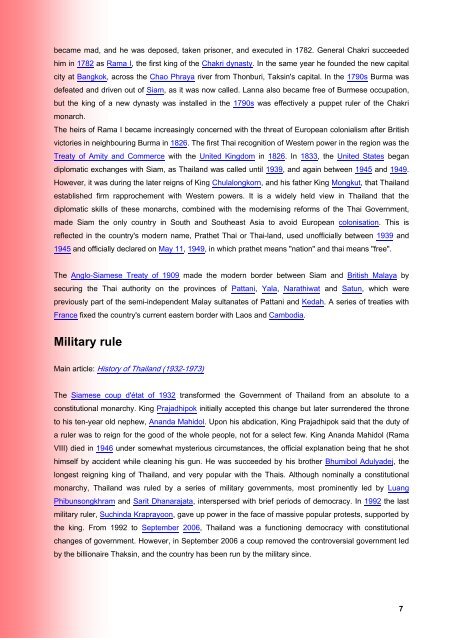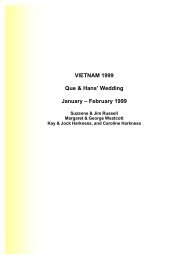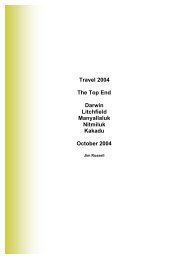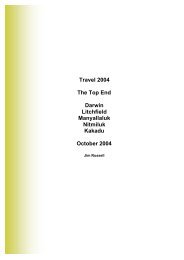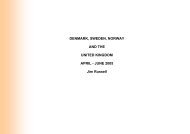- Page 1: 1 Bangkok to Beijing via Laos and V
- Page 4 and 5: 2 Mekong ..........................
- Page 6 and 7: 4 Liuzhou (1) .....................
- Page 10 and 11: In early January 1941, Thailand inv
- Page 12 and 13: Thailand - History (2) http://www.t
- Page 14 and 15: 12 After the fall of Ayudthaya, Gen
- Page 16 and 17: Thailand - History (3) http://www.a
- Page 18 and 19: Thailand - Economy http://en.wikipe
- Page 20 and 21: The Royal Thai Government welcomes
- Page 22 and 23: 20 • production: 118,900 KW·h (2
- Page 24 and 25: 22 Niger • Nigeria • Norway •
- Page 26 and 27: Successive capitals, built at vario
- Page 28 and 29: 26 • Total: 514 000 km² o Land:
- Page 30 and 31: coconut plantations, tin mining, an
- Page 32 and 33: References 30 • This article cont
- Page 34 and 35: and financial center in Southeast A
- Page 36 and 37: officials, middle class professiona
- Page 38 and 39: Bangkok has over 50 districts or kh
- Page 40 and 41: There is also an elected Bangkok Me
- Page 42 and 43: its lobby on the 15th floor, presen
- Page 44 and 45: more commuters, the Hua Lampong sta
- Page 46 and 47: many reasons including to serve the
- Page 48 and 49: published on Fridays that deal with
- Page 50 and 51: 48 • Images and Photos from Bangk
- Page 52 and 53: especially since these areas with t
- Page 54 and 55: convenience of administration, the
- Page 56 and 57: Reference 54 • Official site Retr
- Page 58 and 59:
The great restoration, having taken
- Page 60 and 61:
Parallel to the canal, this edifice
- Page 62 and 63:
Hmong, the Mien, the Lahu and the L
- Page 64 and 65:
http://www.yupparaj.ac.th/webpage/c
- Page 66 and 67:
Wiang Kum Kam was founded in a shal
- Page 68 and 69:
These three kings had earlier devel
- Page 70 and 71:
the armies of Sukhothai after a dis
- Page 72 and 73:
Phaya Mangrai moved into a palace i
- Page 74 and 75:
Phaya Saen Muang Ma also commenced
- Page 76 and 77:
ordered that the image be enshrined
- Page 78 and 79:
http://www.yupparaj.ac.th/webpage/c
- Page 80 and 81:
As Chiang Mai had long been a ghost
- Page 82 and 83:
80 Monthon Phayap In the nineteenth
- Page 84 and 85:
dissatisfied with officials from th
- Page 86 and 87:
http://www.thaifocus.com/history.ht
- Page 88 and 89:
Today Northern Thailand is part of
- Page 90 and 91:
Among the buildings on the plaza is
- Page 92 and 93:
was able to vanish, it could move i
- Page 94 and 95:
92 Ornate models at Doi Suthep Refe
- Page 96 and 97:
far away as the Roman Empire. This
- Page 98 and 99:
96 presentation - Requires 'flash e
- Page 100 and 101:
98 1. Originated from the east edge
- Page 102 and 103:
100 • Midstream On the premise th
- Page 104 and 105:
• References 1) The Mekong - Turb
- Page 106 and 107:
I first saw the Mekong 41 years ago
- Page 108 and 109:
China began its dam building on the
- Page 110 and 111:
Laos - History http://www.visit-lao
- Page 112 and 113:
frequent cause of uprisings. In the
- Page 114 and 115:
to the Pathet Lao crumbled. The Pat
- Page 116 and 117:
elentlessly to recover their nation
- Page 118 and 119:
From the very beginning, Laos seems
- Page 120 and 121:
traditionally consulted for the rel
- Page 122 and 123:
in Thailand. Prior to the twentieth
- Page 124 and 125:
difficult and expensive, and most L
- Page 126 and 127:
124 • Laos • National Biodivers
- Page 128 and 129:
A path against the face of the clif
- Page 130 and 131:
In the meantime, the Khmers founded
- Page 132 and 133:
130 • Thailand: Bangkok, Chiang M
- Page 134 and 135:
Luang Prabang - Royal Palace Museum
- Page 136 and 137:
Karst Formations http://en.wikipedi
- Page 138 and 139:
Mature karst landscapes, where more
- Page 140 and 141:
138 • Limestone mountains of nort
- Page 142 and 143:
140 Geography & Geology http://www.
- Page 144 and 145:
Erosion continues underground, and
- Page 146 and 147:
Spanish: karst (m) expuesto; karst
- Page 148 and 149:
Slovenian word for this very common
- Page 150 and 151:
part of the ground water. The surfa
- Page 152 and 153:
Pictured right: The end of the Rako
- Page 154 and 155:
Cone karst is the more common and l
- Page 156 and 157:
the end of winter, the cavities in
- Page 158 and 159:
Laos has the dubious honour of bein
- Page 160 and 161:
Thattaradtha originally founded a c
- Page 162 and 163:
160 • Pictures of Vientiane on Fl
- Page 164 and 165:
http://www.trekearth.com/gallery/As
- Page 166 and 167:
Vietnam http://www.geographia.com/v
- Page 168 and 169:
The most important festival of the
- Page 170 and 171:
was an independent era. For most of
- Page 172 and 173:
to remove their erstwhile allies, t
- Page 174 and 175:
elatively flat plateaus of basalt s
- Page 176 and 177:
congestion is a serious problem in
- Page 178 and 179:
In the socialist era, the cultural
- Page 180 and 181:
178 • Communist Party of Vietnam
- Page 182 and 183:
Vietnam - History http://www.toserc
- Page 184 and 185:
During the reign of King Minh Mang
- Page 186 and 187:
Vietnam remained internationally is
- Page 188 and 189:
186 Early Independence In 939 AD, t
- Page 190 and 191:
characters for writing official doc
- Page 192 and 193:
190 Meanwhile, the Nguyễ n Lords
- Page 194 and 195:
the Nguyễ n Lords had doubled the
- Page 196 and 197:
Meanwhile, in 1941 Hồ Chí Minh,
- Page 198 and 199:
After April 30th, 1975, an exodus o
- Page 200 and 201:
198 • Mesny, William. 1884. Tungk
- Page 202 and 203:
Republic of Vietnam United States o
- Page 204 and 205:
After the war and following the Jap
- Page 206 and 207:
The Diem era, 1955-1963 Main articl
- Page 208 and 209:
206 In November 1963, the U.S. emba
- Page 210 and 211:
In a televised address, President J
- Page 212 and 213:
preventing the immediate defeat of
- Page 214 and 215:
General Nguyen Ngoc Loan summarily
- Page 216 and 217:
the two nations off against one ano
- Page 218 and 219:
egion into the Central Highlands, s
- Page 220 and 221:
The first U.S. prisoners of war wer
- Page 222 and 223:
Main article: Ho Chi Minh Campaign
- Page 224 and 225:
overthrew Pol Pot's murderous regim
- Page 226 and 227:
Use of chemical defoliants One of t
- Page 228 and 229:
Vietnam Conflict, the Vietnam War,
- Page 230 and 231:
228 10. ^ Robert McNamara et al, Ar
- Page 232 and 233:
230 • Myers, Thomas. Walking Poin
- Page 234 and 235:
When armed conflict heated up betwe
- Page 236 and 237:
supplemented by intense river trans
- Page 238 and 239:
During 1968 the US Air Force undert
- Page 240 and 241:
This round-the-clock aerial effort
- Page 242 and 243:
SAM-7 missile near Tchepone. [50] T
- Page 244 and 245:
launched a counteroffensive with fo
- Page 246 and 247:
244 16. ^ Van Staaveren, p. 104. 17
- Page 248 and 249:
246 55. ^ The little known fall of
- Page 250 and 251:
248 • Lipsman, Samuel, Steven Wei
- Page 252 and 253:
A September 1966 intelligence study
- Page 254 and 255:
once more appeared on the list of b
- Page 256 and 257:
Hanoi http://en.wikipedia.org/wiki/
- Page 258 and 259:
Geography Districts Hanoi comprises
- Page 260 and 261:
merchants, including many silk shop
- Page 262 and 263:
Though representing only 3.6 percen
- Page 264 and 265:
http://www.queencafe.com.vn/History
- Page 266 and 267:
workers constitute only 9% of the p
- Page 268 and 269:
Hang Bac also has jewelers of diffe
- Page 270 and 271:
structure was built over it, and fi
- Page 272 and 273:
Street Name: Description: 1 - Bat D
- Page 274 and 275:
administrative offices provide visi
- Page 276 and 277:
http://www.vietnamembassy-usa.org/l
- Page 278 and 279:
276 • Dong Da district. This is a
- Page 280 and 281:
The northern edge of Hai Phong city
- Page 282 and 283:
Halong Bay & Cat Ba National Park h
- Page 284 and 285:
http://en.wikipedia.org/wiki/Cat_ba
- Page 286 and 287:
http://www.asia-planet.net/vietnam/
- Page 288 and 289:
attract many visitors every year. E
- Page 290 and 291:
288 • People at this stage had na
- Page 292 and 293:
290 • Tang Dynasty was so strong
- Page 294 and 295:
292 • China history since then ha
- Page 296 and 297:
What is now China was inhabited, po
- Page 298 and 299:
296 Shang Dynasty Main article: Sha
- Page 300 and 301:
After further political consolidati
- Page 302 and 303:
Sui Dynasty: Reunification Main art
- Page 304 and 305:
called the Pax Mongolica, adventuro
- Page 306 and 307:
Main article: Qing Dynasty The Qing
- Page 308 and 309:
German, French, US and Austrian tro
- Page 310 and 311:
308 • List of Neolithic cultures
- Page 312 and 313:
310 • Shaffer, Lynda Norene. 1996
- Page 314 and 315:
http://en.wikipedia.org/wiki/Timeli
- Page 316 and 317:
23 25 88 314 Gengshi 105 He Cai Lun
- Page 318 and 319:
1279 Battle of Yamen 1289 Francisca
- Page 320 and 321:
1874 1875 1876 Chefoo Convention 18
- Page 322 and 323:
2003 SARS outbreak 2004 Date Ruling
- Page 324 and 325:
322 • Xia Shang Zhou Chronology P
- Page 326 and 327:
The Dongs, who had all along fought
- Page 328 and 329:
Religion Since ancient times, the D
- Page 330 and 331:
Dong funeral rituals are similar to
- Page 332 and 333:
Like the Han, the Dong has New Year
- Page 334 and 335:
across the water. Corridors and kio
- Page 336 and 337:
Hui Ethnic Group http://library.thi
- Page 338 and 339:
members of the group. Use of a fort
- Page 340 and 341:
on collars, sleeves and trouser leg
- Page 342 and 343:
Crafts: The Miao people are very sk
- Page 344 and 345:
meat are forbidden. For those who o
- Page 346 and 347:
The third type, engaged in by a tin
- Page 348 and 349:
performed when a boy entered manhoo
- Page 350 and 351:
http://www.travelchinaguide.com/int
- Page 352 and 353:
Zhuang Minority Group http://librar
- Page 354 and 355:
In 1851, the Taiping Revolution, th
- Page 356 and 357:
Contemporary Zhuang clothing is in
- Page 358 and 359:
In the past, the Zhuangs had such a
- Page 360 and 361:
The Zhuang people are so hospitable
- Page 362 and 363:
Huashan Cliff Paintings http://engl
- Page 364 and 365:
http://www.gxtravel.com/ReadArt.asp
- Page 366 and 367:
http://www.kepu.net.cn/english/nati
- Page 368 and 369:
Liuzhou http://en.wikipedia.org/wik
- Page 370 and 371:
http://www.china.org.cn/english/TCC
- Page 372 and 373:
http://www.gxtravel.com/Culture/Rea
- Page 374 and 375:
Another celebrated figure in Liuzho
- Page 376 and 377:
374
- Page 378 and 379:
Most of the original culture of the
- Page 380 and 381:
Jian Zhen http://www.mountainsongs.
- Page 382 and 383:
Li River (Lijiang) http://www.china
- Page 384 and 385:
http://en.wikipedia.org/wiki/Lijian
- Page 386 and 387:
384
- Page 388 and 389:
surrounded by the Yuecheng Range ,
- Page 390 and 391:
388 Guilin prospered in the Tang an
- Page 392 and 393:
390 • Guilin Medical College (桂
- Page 394 and 395:
External links 392 • Guilin Map
- Page 396 and 397:
394 • Ling Canal, northeast of Gu
- Page 398 and 399:
Shenzhen, formerly known as Bao'an
- Page 400 and 401:
percent over the previous year. Its
- Page 402 and 403:
China Merchants Holdings (Internati
- Page 404 and 405:
Shenzhen is the candidate of People
- Page 406 and 407:
Hong Kong http://en.wikipedia.org/w
- Page 408 and 409:
A waterfall off the Chinese coast w
- Page 410 and 411:
New Terrorities returning to the PR
- Page 412 and 413:
the government's decision to subsid
- Page 414 and 415:
On 24 September 2005, 25 Hong Kong
- Page 416 and 417:
Main articles: Geography of Hong Ko
- Page 418 and 419:
Hong Kong consists of 18 administra
- Page 420 and 421:
US dollar at the rate of approximat
- Page 422 and 423:
diversity of the territory and inte
- Page 424 and 425:
schools, often run by Christian org
- Page 426 and 427:
424 Easter Monday 復活節星期
- Page 428 and 429:
426 Hong Kong's best-known building
- Page 430 and 431:
now used almost exclusively in Hong
- Page 432 and 433:
2001- World's Best Airports 05 Skyt
- Page 434 and 435:
432 14. ^ Monthly Averages for Hong
- Page 436 and 437:
Radio 434 • Radio Television of H
- Page 438 and 439:
Stanley was the location where the
- Page 440 and 441:
438 • The Old Stanley Police Stat
- Page 442 and 443:
The Peak Tower was designed by the
- Page 444 and 445:
http://en.wikipedia.org/wiki/Peak_T
- Page 446 and 447:
444 • List of buildings and struc
- Page 448 and 449:
Name The Star Ferry makes a "star t
- Page 450 and 451:
448 • Official website • Star F


